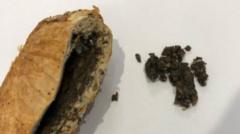Erin Patterson's murder trial, which captivated Australia, concluded with her conviction for the murder of three relatives through a fatal meal featuring death cap mushrooms. Evidence released by the Supreme Court sheds light on the chilling events and Patterson's attempts to conceal her actions.
Toxic Mushrooms and Culinary Crime: Inside the Erin Patterson Trial

Toxic Mushrooms and Culinary Crime: Inside the Erin Patterson Trial
The release of trial evidence, including images of beef Wellington and toxic mushrooms, exposes the chilling details of Erin Patterson's conviction for murder.
Pictures showcasing the infamous beef Wellington implicated in the mushroom murders were unveiled by a court as Australian woman Erin Patterson stands convicted of murdering three family members during a fatal dinner. On July 29, 2023, Patterson, aged 50, was deemed guilty by a jury for serving the deadly meal in the quiet town of Morwell, also attempting to kill a fourth person who survived.
The case, which has drawn national and international attention, revealed that Patterson allegedly sourced death cap mushrooms from nearby regions, ultimately attempting to conceal her actions after the tragedy unfolded by disposing of evidence and misleading authorities. Tragically, three individuals—Patterson's former in-laws Don and Gail Patterson, both aged 70, alongside Gail's sister Heather Wilkinson, 66—succumbed to mushroom poisoning days later in hospital. Ian Wilkinson, Heather's husband, survived following extended treatment.
Amid increasing scrutiny, Patterson's estranged husband, Simon, opted out of the meal, citing discomfort stemming from their strained relationship. Following the jury's verdict, the Supreme Court of Victoria disclosed approximately 100 images that played a pivotal role in the trial, including those of leftovers from the beef Wellington.
The leftover meal remnants, procured from Patterson's residence, were secured in specimen bags to avoid contamination and subsequently subjected to forensic examination for traces of the fatal death cap mushrooms. These toxic fungi, among the deadliest to humans, are notorious for causing severe poisoning, with their toxins remaining potent even through cooking or other preservation methods.
Patterson contended she acquired some mushrooms from an Asian grocery store in Melbourne, lacking specific details such as the location or purchase records. Meanwhile, detectives discovered that sightings of death cap mushrooms had been reported in two towns adjoining Morwell, prompting local residents to share images of the toxic fungi on the online plant database iNaturalist, which Patterson had accessed beforehand.
Furthermore, forensic evidence indicated Patterson visited these locations prior to the meal and purchased a food dehydrator en route home. Images were retrieved from her mobile phone showing what appeared to be death cap mushrooms on weighing scales. Even minimal ingestion of the fungi can result in fatal consequences.
Traces of the toxic mushrooms were later found within a food dehydrator that Patterson disposed of at a local waste site shortly after being discharged from the hospital, where she initially resisted medical attention for herself and her children, who allegedly consumed the leftovers. Despite their claims, none of their tests revealed signs of mushroom poisoning.
The unearthing of an instruction manual for the dehydrator found in Patterson's kitchen contradicted her assertions of never owning such an appliance and further fueled suspicions. Images were also released showing Patterson discarding the dehydrator days following the fatal lunch. With Patterson ultimately facing severe consequences for her actions, this case serves as a grim reminder of the potential dangers lurking within seemingly innocent meals.


















